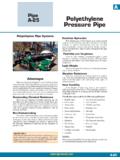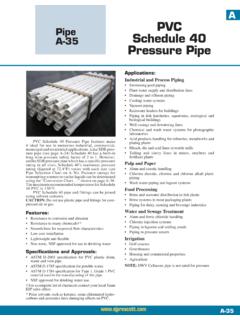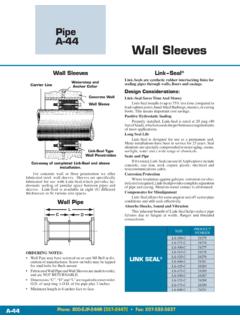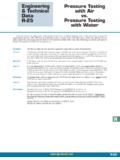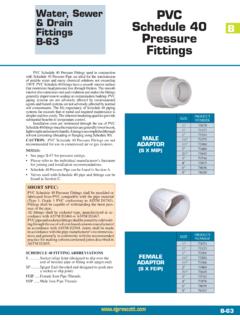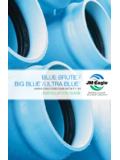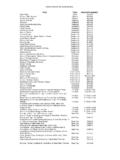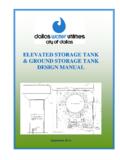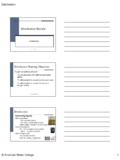Transcription of Engineering & Technical Disinfection Data of New R …
1 Disinfection of New Water MainsDisinfection of mains should be accomplished only by workmen who have had experience with chlorine or other disinfecting agents. Often this work is performed by water utility employees as they are usually well acquainted with the use of chlorine. Liquid chlorine (gas at atmospheric pressure), calcium hypochlorite granules and tablets, and sodium hypochlorite solutions are the most common disinfectants used. Chlo-rine gas and water solutions are fed into the main being disinfected to a concentration of at least 50 avail-able chlorine. To insure that the required concentration is maintained, chlorine residuals are obtained. This chlorinated water solution should remain in the pipe for at least 24 hours, at the end of which period the chlorine concentra-tion should be at least 25 If this is achieved, final flushing can then be accomplished and chlorine residuals checked to determine that the heavily chlorinated water has been removed from the Slug Method of chlorination, which is used for large diameter water mains, consists of moving a column of highly concentrated chlorine water solution (at least 300 ) along the interior of the pipe with a contact time of at least three hours with the pipe Tablet Method is generally used for short ex-tensions up to 2,500 feet of 12 inch and smaller diameter mains.
2 The required number of tablets are placed on the inside top of each joint and held in place by an approved mastic. The main is then filled with water at a velocity of less than 1 fps and the water is left in the main for at least 24 hours before flushing. The table below indicates the number of tablets required for each size of pipe up to 12" in OF HyPOCHlOrITE TablETS OF 5-G rEquIrED FOr DOSE OF 50 ** Based on 33 4 grams available chlorine per EJP Method of chlorination consists of cal-culating the number of gallons of sodium hypochlorite required to disinfect a water main to a concentration of 50 mg/L (PPM).Example: Determine the amount of sodium hypochlo-rite required to disinfect 1100 lf. of 8" pipe and 4800 lf. of 12" pipe using Contents of Pipe table, pag1. e S-11 8" pipe = gallons per 1 foot length 12" pipe = gallons per 1 foot lengthDetermine concentration of availabl2. e chlorine re-quired (usually 50 ppm is minimum standard).
3 1% of a million = 1 ppm = 10,000 in 1,000,000 Determine percentage of chlorine available in sodium 3. hypochlorite being used. Note: Clorox is available chlorine Supershock is available chlorineDetermine volume of water to be chlorinated: 4. 1100 LF of 8" pipe = 2,872 gal. 4800 LF of 12" pipe = 28,204 gal. Total Pipe Volume: = 31,076 gallonsCalculate amount of sodium hypochlorite 5. :x = Gallons of sodium hypochlorite = Required ppm chlorine Volume of pipe in gals. % of chlorine used 1 part of 1,000,000 Where: Required ppm chlorine = 50 PPM % of chlorine used = Volume of pipe = 31,076 gallons 1% (1,000,000) = 10,000 x = 50 31,076 gal. = gal. req d 10,000 After final flushing, bacteriological tests are performed in accordance with state and local regulations to insure that no coliform organisms are present. For more detailed information, refer to AWWA Standard C651 for Disinfect-ing Water OF SECTION (feet)DIAMETER OF PIPE (inches)2"4"6"8"10"12"13 or <112235181123562011235730123571040124691 4 Phone: 800-EJP-24HR (357-2447) Fax: 207-582-5637 Engineering & Technical Data
